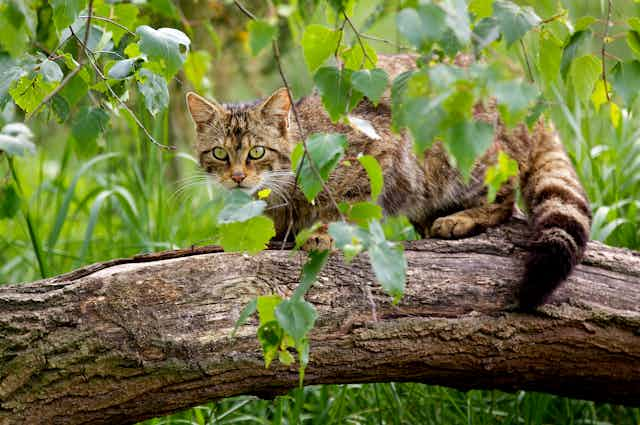You are unlikely to have seen one, but wildcats are still clinging on by a claw in Scotland. Most of the cats living in the wild in Scotland are hybrid cats with a mix of wildcat and domestic cat ancestry or feral domestic cats. But my team’s new study showed they lived alongside domestic cats for almost 2,000 years before interbreeding.
One of our rarest and most elusive mammal species, European wildcats have been in decline across across Europe and Britain for the past few hundred years. Wildcats were lost completely from England and Wales by the end of the 19th century and today are only found in the Scottish Highlands.
Habitat loss and hunting are two of the biggest threats facing this species across its range, but in Scotland, hybridisation with domestic cats is now the biggest threat to this population. Interbreeding between the two species is frequent now.
This gradual erosion of the wildcat genome (the DNA instructions for everything that makes a wildcat a wildcat) may lead to the complete extinction of this species in Britain. Among scientists, this is known as genetic swamping.
How long has this been going on?
Although domestic cats and wildcats are different species, genetically more different than dogs and wolves, they look similar. Domestic cats, descended from the African-Asian wildcat, became widespread in Britain in Roman times.
Wildcats in Scotland are a subpopulation of European wildcats, and have been present in Britain since the end of the last ice age, around 10,000 years ago. Our research, which used the genomes of ancient cats from prehistoric Britain (around 6,000BC) until the present, shows that the two species kept themselves separate until very recently.
This may be expected for two species such as these, which have different patterns of behaviour and habitat preference. Wildcats keep away from people and prefer natural, forested areas – unlike domestic cats which thrive in human-modified environments.
My team’s study showed that around 60 years ago, however, there was a sudden shift to increasingly frequent interbreeding, which quickly overwhelmed the remaining wildcats in Scotland.
What changed?
The recent history of hybridisation between the two species strongly suggests that hybridisation is a symptom, rather than the cause, of wildcat declines in Britain.
Wildcats have been hunted for sport, and are also persecuted as a pest species which keeps their numbers down. Modern land management has involved the felling of large swaths of Scottish forests (often for timber or agriculture), potentially forcing wildcats into more human-dominated environments, where they are more likely to meet a domestic cat.
The 20th century also saw a rise in domestic cat ownership, which is now at an all-time high in the UK. While it can be hard to keep track of feral domestic cat numbers, the population size is likely to significantly outnumber the wildcat population.
Our study highlighted the pressure that disease transmission is putting on wildcat populations. Domestic cats are a known source of feline diseases, such as feline immunodeficiency virus, feline calicivirus and haemoplasma infection, which can be passed to wildcats, and can be deadly.

Our study compared the genomes of hybrid, wildcat and domestic cats. The hybrid population showed genetic patterns suggesting they are developing immunity to these diseases, with the help of genes inherited from domestic cat parents. While this may bring short-term protection from cat diseases, it results in domestic cat DNA hitching along for the ride, perhaps accelerating the effect of genetic swamping.
Without intervention, the few wildcats that remain will interbreed with domestic cats and the wildcat genome will contribute a fraction of a percent to the domestic cat genome. The biological and behavioural adaptations that evolved in the European wildcat will be lost.
Does this matter?
Human behaviour (such as transporting species around the world, encroachment on wild habitats and climate change) is driving an increase in hybridisation globally. Conservationists are debating the level of risk this poses to wildlife populations, and the best course of action for conservation management.
Read more: Hybrid future? Interbreeding can make heat-averse species more resilient to climate change
In some cases hybridisation can be beneficial, bringing new genetic diversity that can help species survive in increasingly human-dominated environments. However, the consequences of hybridisation are unpredictable, and it is hard to come up with a solution that works for every case.
For the wildcat, hybridisation is a double-edged sword. It brought disease resistance that aided the population’s short-term survival, but at the cost of threatening the genetic adaptations that made the species unique.
What next for wildcats?
My team’s study highlights the value of the captive wildcat population in the UK. First established in 1960, founders of this population largely predate the onset of hybridisation in Scotland. The captive population now provides an important lifeline to reestablish this species in Britain.
A wildcat conservation breeding for release programme is conducted by Saving Wildcats, a partnership led by the Royal Zoological Society of Scotland. The first releases into the wild started this year, with 19 cats released in the Cairngorms Connect area of the Cairngorms National Park.
Monitoring the newly released cats will give us vital insights about how to protect species like the wildcat. The more we understand about the effects and history of hybridisation, the more we’ll understand about how best to manage wildlife conservation in the future.

Don’t have time to read about climate change as much as you’d like?
Get a weekly roundup in your inbox instead. Every Wednesday, The Conversation’s environment editor writes Imagine, a short email that goes a little deeper into just one climate issue. Join the 20,000+ readers who’ve subscribed so far.

